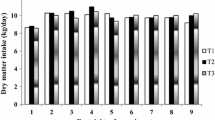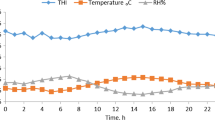Abstract
Seaweeds are rich in minerals. The present experiment was designed to see the effect of replacing minerals and a part of concentrate mixture (CM) by seaweed in cows. Sahiwal cows (n = 12) were randomly blocked into three equal groups on the basis of milk yield (mean 8.39 L/day) and parity. Animals were offered concentrate mixtures along with wheat straw and green oat as total mixed ration (CM and roughages as 50:50; green oat and wheat straw as 60:40) for 126 days. Control animals (T1) were offered CM without mineral and salt premix; group T2 animals had 2 % mineral premix and 1 % salt in their CM while seaweed group (T3) had 20 % seaweed in their CM without additional mineral and salt. The results revealed no significant changes in plasma mineral profile and mineral metabolism except that of copper and zinc (P < 0.01) in the groups without mineral and salt (T1, T3). Milk mineral profile remained similar in all treatment groups except milk phosphorus, copper and zinc which were highest in T2 followed by T1 and T3. A clear trend was reflected in mineral metabolism and its status in blood and milk corresponding to that of dietary mineral composition. Thus, incorporation of brown seaweed in the diet of lactating Sahiwal cows (20 % in concentrate mixture) did not affect mineral metabolism and blood–milk mineral profiles, except copper and zinc; which need to be additionally supplemented in the diet.







Similar content being viewed by others
References
FAOSTAT (2013) Agricultural production database. Food and Agricultural Organization. http://faostat.fao.org/site/573/default.aspx#ancor
Christaki E, Karatzia M, Florou-Paneri P (2010) The use of algae in animal nutrition. J Hellenic Vet Med Soc 61:267–276
Okab AB, Samara EM, Abdoun KA, Rafay J, Ondruska L, Parkanyi V, Pivko J, Ayoub MA, Al-Haidary AA, Aljumaah RS, Peter M, Lukac N (2013) Effects of dietary seaweed (Ulva lactuca) supplementation on the reproductive performance of buck and doe rabbits. J Appl Anim Res 41:347–355
Ventura MR, Castanon JIR (1998) The nutritive value of seaweed (Ulva lactuca) for goats. Small Ruminant Res 29:325–327
Ortiz J, Romero N, Robert P, Araya J, Lopez-Hernández J, Bozzo C, Navarrete E, Osorio A, Rios A (2006) Dietary fiber, amino acid, fatty acid and tocopherol contents of the edible seaweeds Ulva lactuca and Durvillaea antarctica. Food Chem 99:98–104
Holdt SL, Kraan S (2011) Bioactive compounds in seaweed: functional food applications and legislation. J Appl Phycol 23:371–393
Archer GS, Friend TH, Caldwell D, Ameiss K, Krawczel PD, Iacono C, Keen H, Martin T (2008) Impacts of feeding several components of the seaweed Ascophyllum nodosum on transported lambs. Anim Feed Sci Technol 140:258–271
Pompeu LB, Williams JE, Spiers DE, Weaber RL, Ellersieck MR, Sargent KM, Feyerabend NP, Vellios HL, Evans F (2011) Effect of Ascophyllum nodosum on alleviation of heat stress in dairy cows. Prof Anim Sci 27:181–189
Harnedy PA, Fitzgerald RJ (2011) Bioactive proteins, peptides, and amino acids from macroalgae. J Phycol 47:218–232
Lee HG, Lee HJ, Koh TS, Hong ZS, Li ZH, Xu CX, Jin X, Jin MG, Choi YJ, Choi NJ (2005) Effect of brown seaweed waste supplementation on lactational performance and endocrine physiology in Holstein lactating cows. J Anim Sci Technol 47:573–582 (in Korean)
Lee SH, Lee HG, Maeng W, Baek IK, Hwang JH (2004) Effects of the brown seaweed residues supplementation on in vitro fermentation, milk production and composition of lactating dairy cows. J Anim Sci Technol 46:373–386 (in Korean)
Hong ZS, Lee ZH, Xu CX, Yin JL, Jin YC, Lee HJ, Lee SB, Choi YJ, Lee HG (2010) Effect of fermented brown seaweed waste on milk production, composition and physiological responses in Holstein dairy cows. J Anim Sci Technol 52:287–296 (in Korean)
Karatzia M, Christaki E, Bonos E, Karatzias C, Florou-Paneri P (2012) The influence of dietary Ascophyllum nodosum on haematologic parameters of dairy cows. Italian J Anim Sci 11(2):e31
NRC (2001) Nutrient requirement of dairy cattle, 7th rev edn. National Academy Press, National Research Council, Washington, DC
AOAC (2005) Official methods of analysis of AOAC international, 18th edn. Association of Analytical Communities International, Gaithersburg, Maryland, USA
Fiske CH, Subbarow Y (1925) The colorimetric determination of phosphorous. J Biol Chem 66:375–400
Snedecor GW, Cochran WG (1994) Statistical methods, 8th edn. Iowa University Press, Ames, Iowa
Orud I, Homb T (1964) Supplements of seaweed meal for dairy cows, effect on milk yield. Tijdsker Det Norske Landburk 71:137
Leupp JL, Caton JS, Soto-Navarro SA, Lardy GP (2005) Effects of cooked molasses blocks and fermentation extract or brown seaweed meal inclusion on intake, digestion, and microbial efficiency in steers fed low-quality hay. J Anim Sci 83:2938–2945
Gardiner GE, Campbell AJ, O’Doherty JV, Pierce E, Lynch PB, Leonard FC, Stanton C, Ross RP, Lawlor PG (2008) Effect of Ascophyllum nodosum extract on growth performance, digestibility, carcass characteristics and selected intestinal microflora populations of grower-finisher pigs. Anim Feed Sci Technol 141:259–273
Reilly P, O’Doherty JV, Pierce KM, Callan JJ, O’Sullivan JT, Sweeney T (2008) The effects of seaweed extract inclusion on gut morphology, selected intestinal microbiota, nutrient digestibility, volatile fatty acid concentrations and the immune status of the weaned pig. Animal 2:1465–1473
Rey-Crespo F, López-Alonso M, Miranda M (2014) The use of seaweed from the Galician coast as a mineral supplement in organic dairy cattle. Animal 8:580–586
Suttle NF (2010) Mineral nutrition of livestock, 4th edn. CABI Publishing, Wallingford
Aggarwal A, Singh M, Chopra RC (2007) Comparative study of cooling by mist-fan and wallowing on mineral profile of Murrah buffalo during summer. Indian J Dairy Sci 60:371–373
Acknowledgments
The authors thank Deputy Director General of Fisheries, Indian Council of Agricultural Research, New Delhi, India for providing the seaweed for this research under A.P. Cess Project on “Cattle feed production from selected seaweeds of Indian coast”. The first author thanks ICAR, New Delhi for providing him financial support in the form of Junior Research Fellowship for his Masters Programme. All authors declare that they have no conflicts of interest.
Author information
Authors and Affiliations
Corresponding author
Rights and permissions
About this article
Cite this article
Singh, B.K., Chopra, R.C., Rai, S.N. et al. Effect of Feeding Seaweed as Mineral Source on Mineral Metabolism, Blood and Milk Mineral Profile in Cows. Proc. Natl. Acad. Sci., India, Sect. B Biol. Sci. 86, 89–95 (2016). https://doi.org/10.1007/s40011-014-0413-9
Received:
Revised:
Accepted:
Published:
Issue Date:
DOI: https://doi.org/10.1007/s40011-014-0413-9




